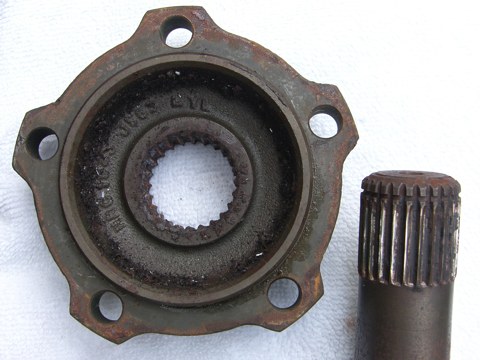Since owning my Landrover (1997 300tdi 110)I have always had to be careful changing gear, the gearbox works fine – never had an issue selecting gear etc. However, when I release my foot off the accelerator there was a slight jolt or jump, then if I did ‘normal modern car’ style gear changes i.e foot up off the clutch quickly then gas on there was a small clunk, I stopped this by driving properly and releasing the clutch slowly and applying acceleration slowly at the same time.
More recently this has got worse and the Landover just had work done (including a 40mm lift) which has certainly made the noise a lot worse. A solid clunk sound occurs under the following situations:
My issue is though, that this clunk sounds bad you can feel it in the vehicle as well as hear it, so I want to stop it – or at least make it slightly less scary!
So far I have been underneath, handbrake on and found the following – no movement in rear UJ’s, no rotation in rear prop, no lateral movement in rear prop. No movement in front UJ’s, no lateral movement in front prop, but the front prop rotates about an inch or so. I then repeated the same but with the handbrake off and found no movement in any UJ, no lateral movement in both prop. But both props rotated about an inch to an inch and a half.
I am no mechanic, and very inexperienced when it comes to anything mechanical, but what I conclude is that the props and UJs are probably alright and the cause is more than likely the output shafts (?) on the transfer box and the differentials – worn components and the ‘clunk’ is the slack being taken up.
I have a road rip coming up for 18 days, we will probably cover 1500 miles, annoyingly we are leaving this Friday so no time to work on the problem and I think the best solution at the moment is being careful when driving. I have read a few posts by people with similar problems and the problem seems common and the solutions often seems to be ignoring it, so am I okay to just turn the radio up?
Once I am back I plan to sort this issue though. My though process is as follows, once the clunk is eliminated I will stop going down the list:
Is that a sensible approach? Am I missing anything? Where is the best place to start?
I am aware than many people have this issue and simply choose to ignore it, though for the meantime I am doing just that I am concerned about the additional wear and tear this will have on other transmission components.
More recently this has got worse and the Landover just had work done (including a 40mm lift) which has certainly made the noise a lot worse. A solid clunk sound occurs under the following situations:
- When going up gears (most noticeably 2nd to 3rd)
- When the engine is struggling with a gear i.e. when I am driving in a 30mph zone in 4th gear as 3rd seems to be too low
- Occasionally when idling towards a stop when in gear but no acceleration applied
My issue is though, that this clunk sounds bad you can feel it in the vehicle as well as hear it, so I want to stop it – or at least make it slightly less scary!
So far I have been underneath, handbrake on and found the following – no movement in rear UJ’s, no rotation in rear prop, no lateral movement in rear prop. No movement in front UJ’s, no lateral movement in front prop, but the front prop rotates about an inch or so. I then repeated the same but with the handbrake off and found no movement in any UJ, no lateral movement in both prop. But both props rotated about an inch to an inch and a half.
I am no mechanic, and very inexperienced when it comes to anything mechanical, but what I conclude is that the props and UJs are probably alright and the cause is more than likely the output shafts (?) on the transfer box and the differentials – worn components and the ‘clunk’ is the slack being taken up.
I have a road rip coming up for 18 days, we will probably cover 1500 miles, annoyingly we are leaving this Friday so no time to work on the problem and I think the best solution at the moment is being careful when driving. I have read a few posts by people with similar problems and the problem seems common and the solutions often seems to be ignoring it, so am I okay to just turn the radio up?
Once I am back I plan to sort this issue though. My though process is as follows, once the clunk is eliminated I will stop going down the list:
- Change prop shafts and UJ’s, though this is probably not the cause of the issue I have wanted to upgrade my prop shafts anyway due to the lift.
- Change transfer case output shafts.
- Change half shafts (upgrade them to HD ones to allow for larger tyres in the future – maybe).
- Look at differentials (???)
- Get someone who actually knows what they are doing in….
Is that a sensible approach? Am I missing anything? Where is the best place to start?
I am aware than many people have this issue and simply choose to ignore it, though for the meantime I am doing just that I am concerned about the additional wear and tear this will have on other transmission components.


